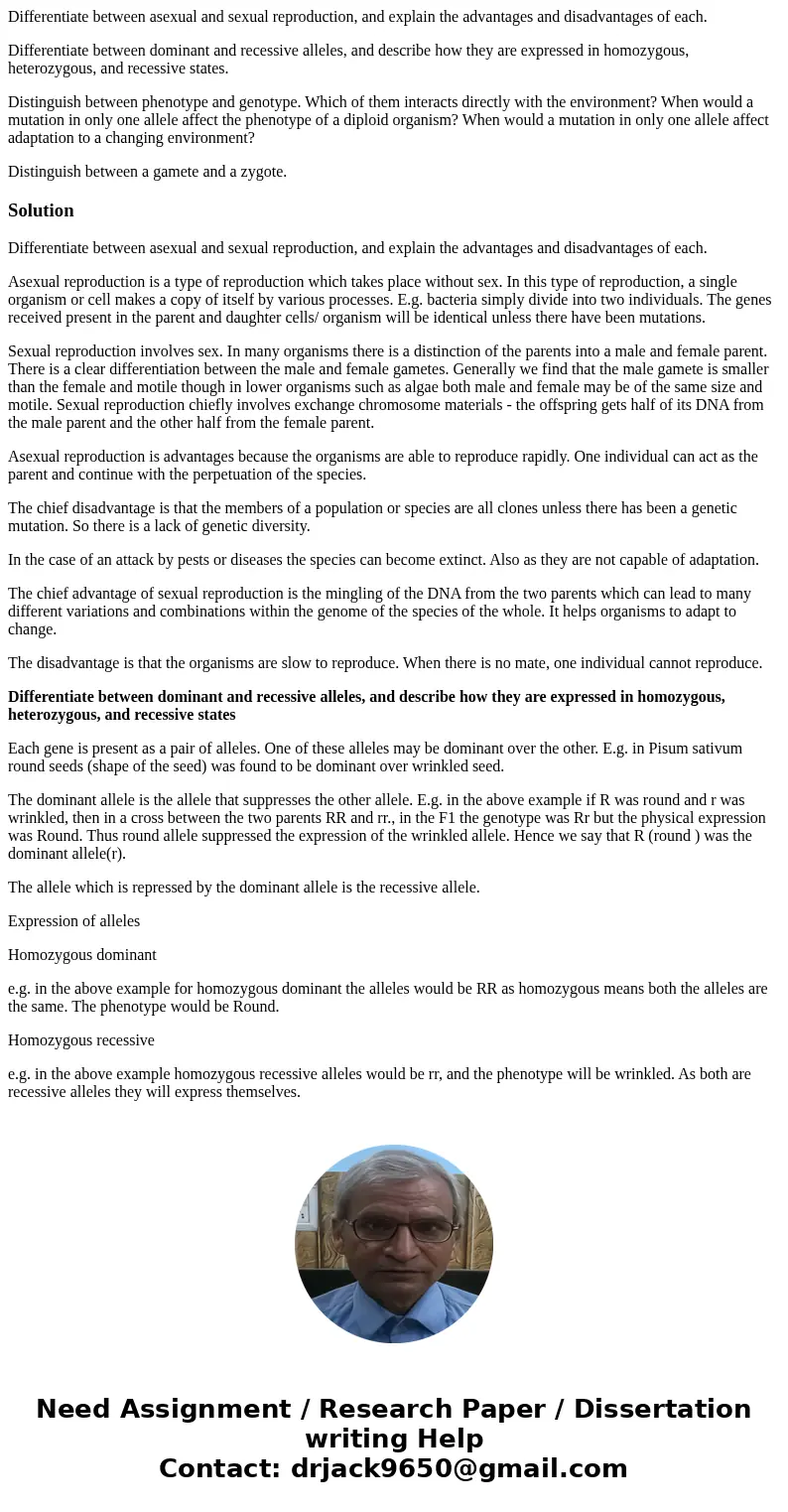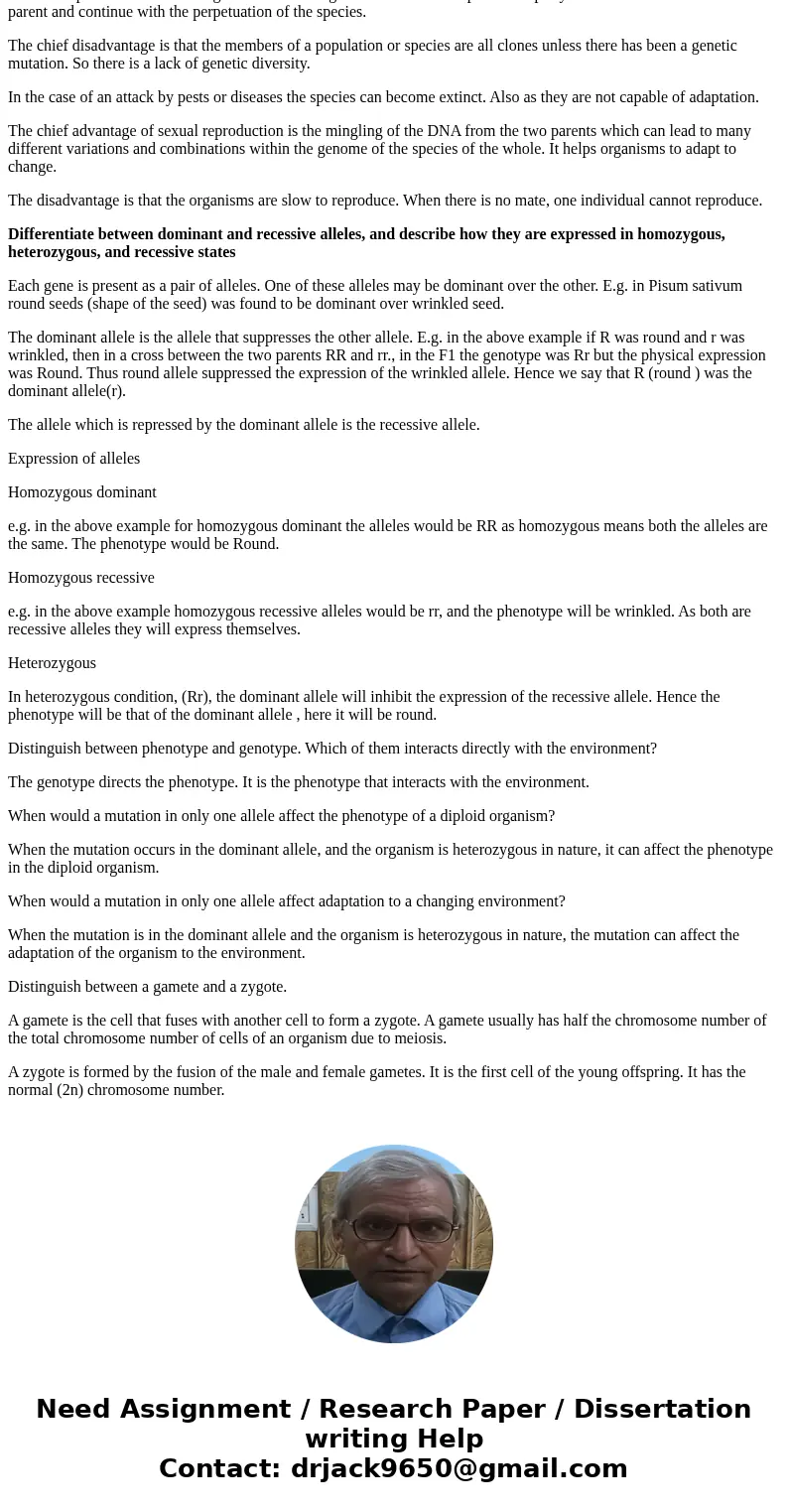Differentiate between asexual and sexual reproduction and ex
Differentiate between asexual and sexual reproduction, and explain the advantages and disadvantages of each.
Differentiate between dominant and recessive alleles, and describe how they are expressed in homozygous, heterozygous, and recessive states.
Distinguish between phenotype and genotype. Which of them interacts directly with the environment? When would a mutation in only one allele affect the phenotype of a diploid organism? When would a mutation in only one allele affect adaptation to a changing environment?
Distinguish between a gamete and a zygote.
Solution
Differentiate between asexual and sexual reproduction, and explain the advantages and disadvantages of each.
Asexual reproduction is a type of reproduction which takes place without sex. In this type of reproduction, a single organism or cell makes a copy of itself by various processes. E.g. bacteria simply divide into two individuals. The genes received present in the parent and daughter cells/ organism will be identical unless there have been mutations.
Sexual reproduction involves sex. In many organisms there is a distinction of the parents into a male and female parent. There is a clear differentiation between the male and female gametes. Generally we find that the male gamete is smaller than the female and motile though in lower organisms such as algae both male and female may be of the same size and motile. Sexual reproduction chiefly involves exchange chromosome materials - the offspring gets half of its DNA from the male parent and the other half from the female parent.
Asexual reproduction is advantages because the organisms are able to reproduce rapidly. One individual can act as the parent and continue with the perpetuation of the species.
The chief disadvantage is that the members of a population or species are all clones unless there has been a genetic mutation. So there is a lack of genetic diversity.
In the case of an attack by pests or diseases the species can become extinct. Also as they are not capable of adaptation.
The chief advantage of sexual reproduction is the mingling of the DNA from the two parents which can lead to many different variations and combinations within the genome of the species of the whole. It helps organisms to adapt to change.
The disadvantage is that the organisms are slow to reproduce. When there is no mate, one individual cannot reproduce.
Differentiate between dominant and recessive alleles, and describe how they are expressed in homozygous, heterozygous, and recessive states
Each gene is present as a pair of alleles. One of these alleles may be dominant over the other. E.g. in Pisum sativum round seeds (shape of the seed) was found to be dominant over wrinkled seed.
The dominant allele is the allele that suppresses the other allele. E.g. in the above example if R was round and r was wrinkled, then in a cross between the two parents RR and rr., in the F1 the genotype was Rr but the physical expression was Round. Thus round allele suppressed the expression of the wrinkled allele. Hence we say that R (round ) was the dominant allele(r).
The allele which is repressed by the dominant allele is the recessive allele.
Expression of alleles
Homozygous dominant
e.g. in the above example for homozygous dominant the alleles would be RR as homozygous means both the alleles are the same. The phenotype would be Round.
Homozygous recessive
e.g. in the above example homozygous recessive alleles would be rr, and the phenotype will be wrinkled. As both are recessive alleles they will express themselves.
Heterozygous
In heterozygous condition, (Rr), the dominant allele will inhibit the expression of the recessive allele. Hence the phenotype will be that of the dominant allele , here it will be round.
Distinguish between phenotype and genotype. Which of them interacts directly with the environment?
The genotype directs the phenotype. It is the phenotype that interacts with the environment.
When would a mutation in only one allele affect the phenotype of a diploid organism?
When the mutation occurs in the dominant allele, and the organism is heterozygous in nature, it can affect the phenotype in the diploid organism.
When would a mutation in only one allele affect adaptation to a changing environment?
When the mutation is in the dominant allele and the organism is heterozygous in nature, the mutation can affect the adaptation of the organism to the environment.
Distinguish between a gamete and a zygote.
A gamete is the cell that fuses with another cell to form a zygote. A gamete usually has half the chromosome number of the total chromosome number of cells of an organism due to meiosis.
A zygote is formed by the fusion of the male and female gametes. It is the first cell of the young offspring. It has the normal (2n) chromosome number.


 Homework Sourse
Homework Sourse